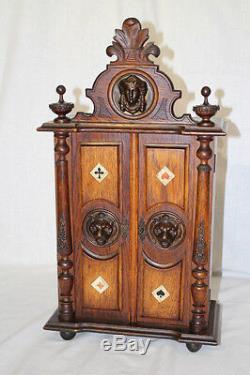Late 19th Century Card Game Table Cabinet Individual Suite Drawers Lion Head


Late 19th Century Card Game Table Cabinet; Individual Suite Drawers; Lion Head. Unique 1890's Continental miniature oak armoire/cabinet designed to hold cards & card game paraphernalia. This is a table top cabinet and stands level.
Elaborate exterior, with lions masks centered on both doors, turned pilasters and finials, and a carved crest with a Minerva head medallion. The four card suites are painted on the front doors. The doors lock, and heave their original key.
The cabinet sits on bun feet. The solid oak doors open to reveal multiple storage compartments, including four drawers, each painted with a card suite design. The finish is in excellent condition, showing just typical darkening and wear to edges - all very minor and expected.
The top portion of the crest has been re-glued, and there is a small piece of metal trim missing off of one of the pillars of about 1/2. Measures 21.75" tall, and 12" wide and 6.25 deep at the cornice and base.
The item will be hand delivered directly to your residence or business. As the longtime director of design for the Dunbar furniture company, Edward Wormley was, along with such peers as George Nelson at Herman Miller Inc.
And Florence Knoll of Knoll Inc. One of the leading forces in bringing modern design into American homes in the mid 20th century. Not an axiomatic modernist, Wormley deeply appreciated traditional design, and consequently his work has an understated warmth and a timeless quality that sets it apart from other furnishings of the era.
Wormley was born in rural Illinois and as a teenager took correspondence courses from the New York School of Interior Design. Marshall Field hired Wormley in 1930 to design a line of reproduction 18th-century English furniture; the following year he was hired by the Indiana-based Dunbar, where he quickly distinguished himself. It was a good match.
Dunbar was an unusual firm: it did not use automated production systems; its pieces were mostly hand-constructed. For his part, Wormley did not use metal as a major component of furniture; he liked craft elements such as caned seatbacks, tambour drawers, or the woven-wood cabinet fronts seen on his Model 5666 sideboard of 1956. He designed two lines for Dunbar each year one traditional, one modern until 1944, by which time the contemporary pieces had become the clear best sellers. Many of Wormleys signature pieces are modern interpretations of traditional forms.
His 1946 Riemerschmid Chair an example is in the collection of the Museum of Modern Art recapitulates a late 19th-century German design. The long, slender finials of his Model 5580 dining chairs are based on those of Louis XVI chairs; his Listen-to-Me Chaise (1948) has a gentle Rococo curve; the Precedent line that Wormley designed for Drexel Furniture in 1947 is a simplified, pared-down take on muscular Georgian furniture. But he could invent new forms, as his Magazine Table of 1953, with its bent wood pockets, and his tiered Magazine Tree (1947), both show. And Wormley kept his eye on design currents, creating a series of tables with tops that incorporate tiles and roundels by the great modern ceramicists Otto and Gertrud Natzler.As the items on these pages demonstrate, Edward Wormley conceived of a subdued sort of modernism, designing furniture that fits into any decorating scheme and does not shout for attention. Please view the total listing as there are more pictures at the bottom of the listing.
Please make sure you read all of our ad and view all the photos. Thank you for visiting with us. Come back often to our store which features antiques and other items we acquire at estate sales and auctions. FREE scheduling, supersized images and templates. Make your listings stand out with FREE Vendio custom templates!
Over 100,000,000 served. Get FREE counters from Vendio today! The item "Late 19th Century Card Game Table Cabinet Individual Suite Drawers Lion Head" is in sale since Monday, June 26, 2017.
This item is in the category "Antiques\Furniture\Tables\Post-1950". The seller is "antiqueboutique*123" and is located in Aurora, Illinois. This item can be shipped worldwide.
